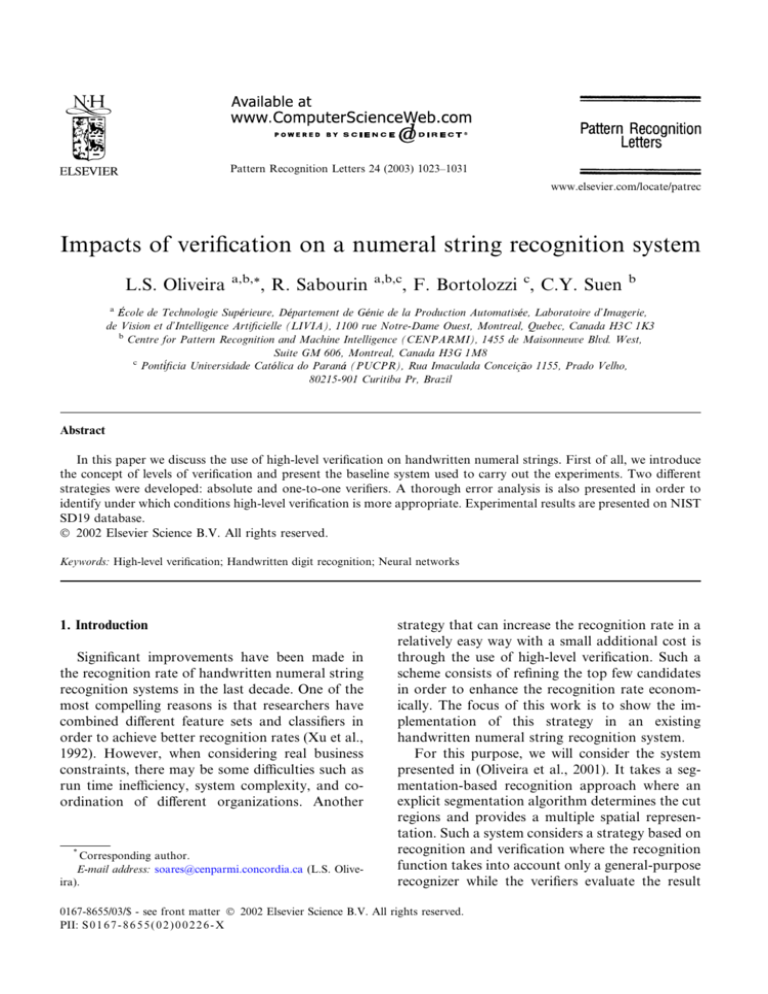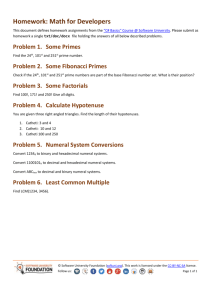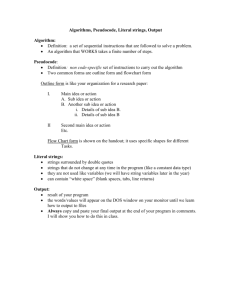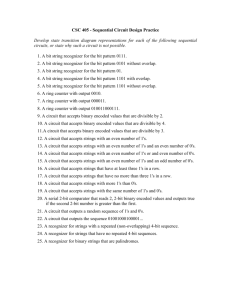
Pattern Recognition Letters 24 (2003) 1023–1031
www.elsevier.com/locate/patrec
Impacts of verification on a numeral string recognition system
L.S. Oliveira
a,b,*
, R. Sabourin
a,b,c
, F. Bortolozzi c, C.Y. Suen
b
a Ecole de Technologie Sup
erieure, D
epartement de G
enie de la Production Automatis
ee, Laboratoire d’Imagerie,
de Vision et d’Intelligence Artificielle (LIVIA), 1100 rue Notre-Dame Ouest, Montreal, Quebec, Canada H3C 1K3
b
Centre for Pattern Recognition and Machine Intelligence (CENPARMI), 1455 de Maisonneuve Blvd. West,
Suite GM 606, Montreal, Canada H3G 1M8
c
Pontificia Universidade Cat
olica do Paran
a (PUCPR), Rua Imaculada Conceicßa~o 1155, Prado Velho,
80215-901 Curitiba Pr, Brazil
Abstract
In this paper we discuss the use of high-level verification on handwritten numeral strings. First of all, we introduce
the concept of levels of verification and present the baseline system used to carry out the experiments. Two different
strategies were developed: absolute and one-to-one verifiers. A thorough error analysis is also presented in order to
identify under which conditions high-level verification is more appropriate. Experimental results are presented on NIST
SD19 database.
Ó 2002 Elsevier Science B.V. All rights reserved.
Keywords: High-level verification; Handwritten digit recognition; Neural networks
1. Introduction
Significant improvements have been made in
the recognition rate of handwritten numeral string
recognition systems in the last decade. One of the
most compelling reasons is that researchers have
combined different feature sets and classifiers in
order to achieve better recognition rates (Xu et al.,
1992). However, when considering real business
constraints, there may be some difficulties such as
run time inefficiency, system complexity, and coordination of different organizations. Another
*
Corresponding author.
E-mail address: soares@cenparmi.concordia.ca (L.S. Oliveira).
strategy that can increase the recognition rate in a
relatively easy way with a small additional cost is
through the use of high-level verification. Such a
scheme consists of refining the top few candidates
in order to enhance the recognition rate economically. The focus of this work is to show the implementation of this strategy in an existing
handwritten numeral string recognition system.
For this purpose, we will consider the system
presented in (Oliveira et al., 2001). It takes a segmentation-based recognition approach where an
explicit segmentation algorithm determines the cut
regions and provides a multiple spatial representation. Such a system considers a strategy based on
recognition and verification where the recognition
function takes into account only a general-purpose
recognizer while the verifiers evaluate the result
0167-8655/03/$ - see front matter Ó 2002 Elsevier Science B.V. All rights reserved.
PII: S 0 1 6 7 - 8 6 5 5 ( 0 2 ) 0 0 2 2 6 - X
1024
L.S. Oliveira et al. / Pattern Recognition Letters 24 (2003) 1023–1031
supplied by the recognizer. The integration of all
modules is done through a probabilistic model
inspired by information theory.
In this work we start by introducing the concept
of levels of verification and present a brief overview of the system. Afterwards, we describe two
different strategies of high-level verification as well
as the results achieved by them. All experiments
reported in this work were carried out on NIST
SD19 database. In order to get a better comprehension of the system, we show a strong error
analysis. Finally, we outline the perspectives for
future works and present our conclusions.
2. Levels of verification
The recognition and verification scheme looks
straightforward, with a verification module embedded in the traditional classification system,
which has a general-purpose recognizer only. The
goal of the general-purpose recognizer is to attribute a given input to one of the n existing classes
of the system, while the pattern verifier assumes
the role of an expert to evaluate precisely the result
of the recognizer in order to compensate for its
weakness due to particular training, and consequently to make the whole system more reliable.
Usually, a pattern verifier is applied after a general-purpose recognizer and it is designed to ‘‘plug
and play’’, i.e., it is used without knowing the
implementation details of the recognition modules.
Takahashi and Griffin (1993) define three kinds
of verification: absolute verification for each class
(Is it a ‘‘0’’ ?), one-to-one verification between two
categories (Is it a ‘‘4’’ or a ‘‘9’’ ?) and verification in
clustered, visually similar, categories (Is it a ‘‘0’’,
‘‘6’’ or ‘‘8’’ ?).
In addition to these definitions, we introduce
the concept of levels of verification, where two
levels are considered: high-level and low-level. We
define as high-level verifiers those that deal with a
sub-set of the classes considered by the generalpurpose recognizer. The goal of the verifiers at this
level is to confirm or deny the hypotheses produced by the general-purpose recognizer by recognizing them (Takahashi and Griffin, 1993; Zhou
et al., 2000). We define as low-level verifiers those
that deal with meta-classes of the system such as
characters and part of them. The purpose of a lowlevel verifier is not to recognize a character, but
rather to determine whether a hypothesis generated by the general-purpose recognizer is valid or
not (Cho et al., 2000).
3. System overview
Basically the baseline system used in this work
(Oliveira et al., 2001) is composed of four parts:
component detection and segmentation, feature
extraction, recognition and verification and postprocessing. Due to the restricted space we have
here, we will discuss just the recognition and verification module.
The feature extraction is composed of three
different feature sets. The first one, which feeds the
general-purpose recognizer, uses a mixture of
concavity and contour based features. The second
one, which feeds the over-segmentation verifier, is
based on a multi-level concavity analysis. The last
feature set, which feeds the under-segmentation
verifier, takes into account the same concavity
analysis used by the general-purpose recognizer.
The baseline system is composed of all modules
depicted in Fig. 1 except the gray ones, which
represent the feature set and the high-level verifier.
Although many types of neural networks can be
used for classification purposes, we opted for a
multi-layer perceptron (MLP) which is the most
widely studied and used neural network classifier.
Therefore, all classifiers presented in this work are
MLPs trained with the backpropagation algorithm
(Rumelhart et al., 1995). The training and validation sets were composed of 195,000 and 28,000
samples from hsf_{0,1,2,3} series respectively
while the test set was composed of 60,089 samples
from hsf_7 series. The recognition rates (zerorejection level) achieved by the general-purpose
recognizer were 99.66%, 99.45%, and 99.13% on
the training, validation, and test sets respectively.
The recognition system also considers two verifiers to cope with the over-segmentation and
under-segmentation problems. The objective of
these verifiers is to validate the general-purpose
recognizer hypotheses by using the following
L.S. Oliveira et al. / Pattern Recognition Letters 24 (2003) 1023–1031
1025
Fig. 1. Block diagram of a numeral string recognition system.
meta-classes: characters, part of characters and
under-segmented characters. The over-segmentation verifier was trained with 28,000 samples and it
reached a recognition rate of 99.40% on the test set
(14,000 samples) while the under-segmentation
verifier was trained with 9000 samples and it
reached a recognition rate of 99.17% on the test set
(4000 samples). We have shown that such verifiers
(vo and vu in Fig. 1) provided an improvement of
about 7% in the recognition rate for numeral
strings. However, it is important to emphasize that
these verifiers are low-level verifiers and hence we
will not discuss how they work in this paper.
4. High-level verification
As mentioned previously, the goal of the
high-level verification is to confirm or deny the
hypotheses produced by the general-purpose recognizer by recognizing them. In this section we
discuss two different strategies of high-level verification: absolute and one-to-one. We will describe
how such verifiers were implemented as well as
why they contribute to improve the recognition
rate of the system in some cases and why they fail
in others. We can see this in Fig. 1, where the gray
boxes represent the feature set and the absolute
verifiers.
All verifiers presented in this work are MLPs
trained with the gradient descent applied to a sumof-squares error function (Bishop, 1995). The
transfer function employed is the familiar sigmoid
function. In order to monitor the generalization
performance during learning and terminate the
algorithm when there is no longer an improvement, we have used the method of cross-validation. Such a method takes into account a
validation set, which is not used for learning, to
measure the generalization performance of the
network. During learning, the performance of the
network on the training set will continue to improve, but its performance on the validation set
will only improve to a point, where the network
starts to overfit the training set, that the learning
algorithm is terminated. The databases used were
the same that we described in the previous section.
All networks have one hidden layer where the
units of input and output are fully connected with
units of the hidden layer.
4.1. Absolute high-level verifier
In this experiment 10 absolute verifiers (one for
each numerical class) were considered. Each verifier was trained with two classes: digit and noise.
For example, for the verifier of the digit class 0, we
have used all zeros of the training set (19,500
samples) for the digit class and the same number of
other digits for the noise class. We have tried different feature sets such as concavity analysis in 8Freeman directions and moments (Hu, 1962). The
feature set that produced better results was the
same one used by the general-purpose recognizer.
Table 1 shows the recognition rates reached by
each absolute high-level verifier.
1026
L.S. Oliveira et al. / Pattern Recognition Letters 24 (2003) 1023–1031
Table 1
Recognition rates achieved by the absolute high-level verifiers
Class
RR (%)
0
1
2
3
4
5
6
7
8
9
99.66
99.08
99.58
99.20
99.80
99.66
99.50
99.84
99.28
99.10
According to the probabilistic model used by
the baseline system, the output of the recognition
module will be the product of four probabilities:
the probability supplied by the general-purpose
recognizer, the probability supplied by its respective high-level verifier and the probabilities yielded
by the two low-level verifiers (Fig. 1).
We have observed that this strategy of verification produces an improvement to naturally isolated digits, however, when the system faces
problems such as touching and fragmentation, it
does not seem very appropriate. Table 2 presents
the results on different string lengths on NIST
SD19 (hsf_7 series). It is worth of remark that 1digit string (Table 2) means that isolated digits are
submitted to the system modules without any a
priori knowledge of the image. In addition to
recognition errors, segmentation and fragmentation errors are also considered and consequently
the system reaches lower recognition rates than
when the isolated digit is submitted directly to
Table 2
Recognition rates (%––zero-rejection level) for numeral strings:
(A) system without verifiers, (B) system with low-level verifiers,
(C) system B with absolute verification and (D) system B with
one-to-one verification
String
length
Number
of strings
System
A
B
C
D
1
2
3
4
5
6
10
60,089
2370
2385
2345
2316
2169
1215
93.71
91.56
87.98
84.91
82.00
85.66
78.97
98.06
96.88
95.38
93.38
92.40
93.12
90.24
98.72
96.65
95.03
92.97
92.01
92.60
89.51
98.02
96.10
94.98
92.91
91.03
91.77
89.00
feature extraction and recognition. As we can see,
the overall performance achieved for numeral
strings by the system that considers the absolute
verifiers is worse than the baseline system. This can
be explained by the fact that strings with more
than one digit present several cases of fragmentation and touching.
This strategy seems to be suitable for systems
that have a weak general-purpose recognizer or
systems that do not face problems such as touching and fragmentation very often. In such cases,
the verifier can re-rank the list of hypotheses in
order to get the correct answer.
In Table 2 we can also see the importance of the
low-level verifiers. For details about them, see
(Oliveira et al., 2001).
5. One-to-one high-level verifier
The second strategy of high-level verification
that we have implemented was the one-to-one
verifier. Such a strategy is straightforward and
makes it easy to concentrate on the local difference
between two classes. In order to determine the
main confusions of the baseline system, we carried
out an error analysis on the validation set of
isolated digits and we observed 39 different confusions (theoretically, the number of possible
confusing digit pairs is 10 9=2 ¼ 45). We can
solve 75.05% and 62.76% of all errors focusing on
the top-39 and top-20 confusions respectively.
Therefore, it seems more cost effective focusing on
top-20 confusions, since we have to deal with
about 50% of the confusions produced by the
system. Table 3 presents top-20 confusions with
their respective frequencies.
We trained each verifier with 40,000 samples
(20,000 for each class of digit involved) using the
same feature set that we have used for our generalpurpose recognizer. For these verifiers we have
tried different feature sets such as Edge Maps
(Chim et al., 1998) and histograms, but the one
that brought better results was the same one used
by the general-purpose recognizer. Thereafter, we
used the one-to-one verifiers in the same manner
we have used the absolute verifiers. Thus, for this
experiment the gray module ‘‘high-level verifier’’ in
L.S. Oliveira et al. / Pattern Recognition Letters 24 (2003) 1023–1031
Table 3
Top-20 digit confusion with frequencies
Confusion
Frequency
8–0
3–2
2–1
4–0
7–3
9–7
9–4
5–3
6–0
8–3
7–1
9–5
7–2
9–8
8–2
6–4
6–5
8–5
9–0
8–4
48
40
29
28
28
28
27
22
22
22
17
17
16
15
15
14
12
11
11
10
1027
the results supplied by this strategy, it is necessary
to improve the verifier training set by including
misrecognized samples. The difficulties of implementing such a solution lie in two points: (i) Lack
of samples to improve the database. If we consider
our most frequent confusion (8-0), we have just 48
cases, and (ii) if we include a few misrecognized
samples in the training set of the verifier, probably
we will introduce noise to our models. We can
visualize this problem from Fig. 2.
In order to identify the different sources of error
of the system and find why the high-level verification schemes achieved unsatisfactory results, we
decided to carry out an error analysis on numeral
strings instead of isolated digits.
6. Error analysis on numeral strings
In order to gain a better insight of the system,
we divided the errors into four classes: confusions
generated by the general-purpose recognizer, confusions generated by the low-level verifiers, errors
caused by segmentation and errors caused by
fragmentation. This analysis was carried out considering the baseline system. Table 4 describes all
sources of errors as well as its frequency per string
size.
We can read Table 4 in the following way. For
2-digit strings, we have detected 74 errors which
Fig. 1 means the one-to-one verifiers. Table 2
(System D) presents the results achieved by this
strategy for different string lengths.
As we can notice, this strategy gave worse results than the previous one (System C). We expected better results at least for 1-digit string
problem, once the confusions were detected on the
isolated digit database. But even for this case the
results were unsatisfactory. In order to enhance
Fig. 2. Misrecognized samples: 8 confused with 6 and 9 confused with 7.
Table 4
Distribuition of the system errors
String
length
G-P recognizer
Segmentation
Fragmentation
Total
Errors
%
Top-10
%
Errors
Verifier
%
Errors
%
Errors
%
Errors
%
2
3
4
5
6
10
43
78
104
126
98
89
1.81
3.26
4.46
5.43
4.49
6.73
31
40
53
72
65
55
1.31
1.67
2.27
3.10
2.98
4.16
15
15
20
11
31
8
0.64
0.64
0.86
0.48
1.42
0.60
9
9
17
14
13
9
0.38
0.38
0.73
0.60
0.59
0.68
7
8
13
25
8
23
0.29
0.33
0.56
1.08
0.37
1.74
74
110
154
176
150
129
3.12
4.61
6.61
7.59
6.87
9.75
1028
L.S. Oliveira et al. / Pattern Recognition Letters 24 (2003) 1023–1031
correspond to a global error rate of 3.12%. This
error is divided into the following: 43 due to the
general-purpose recognizer, 15 to low-level verifiers, 9 to segmentation and 7 to fragmentation. By
focusing on the top-10 confusions of the generalpurpose recognizer, we can correct 31 of the 43
errors found. In the following subsections, we will
give more details about each source of error.
Fig. 3. Confusion between 9 and 7: (a) original image, (b) best
hypothesis of segmentation–recognition and (c) correct hypothesis.
6.1. General-purpose recognizer
6.2. Low-level verifiers
In order to generate the total number of confusions for numeral strings, we carried out the
analysis for each string length independently and
afterwards we summarized the results to compare
with the confusions obtained for isolated digits.
The first interesting fact we observed was that
we have different confusions for different string
lengths. This means that a verification strategy
based on one-to-one verifier could generate improvements for some string lengths but will be
difficult to optimize globally the system with this
strategy. Table 5 summarizes the top-10 confusions for each string length.
If we compare the top-10 confusions found on
numeral strings (Table 5) with the top-10 confusions found on isolated digits (Table 3), we can
observe that the confusions do not respect the
same order, and some of the numeral string confusions even do not exist for isolated digits. We
can cite for example, 7–2, 4–1 and 7–1 pair confusions. We observed that the effects generated by
the segmentation algorithm such as ligatures produce several confusions. Fig. 3 shows the problem
of the confusion between 9–7 (top-1 confusion).
We divided the error of the low-level verifiers
into two classes: confusion generated by the oversegmentation verifier and confusion generated by
the under-segmentation verifier. We have observed
that the latter is responsible for 87.7% of the errors
generated at this level, while the former generates
just 12.3% of the errors. About the second lowlevel verifier, the confusions are generated when
isolated digits are classified as under-segmented
digits. The classes where this kind of confusion
occurs are the digit classes 6 (44%), 0 (22%), 8
(17%), 4 (12%) and 2 (5%). Fig. 4 shows some
examples of these classes of digits.
Fig. 4. Digits confused with under-segmented class by the
second low-level verifier. This kind of 8 and 0 are sometimes
misverified by the first verifier.
Table 5
Top-10 digit confusion with frequencies per string length
2-Digit
3-Digit
4-Digit
5-Digit
6-Digit
10-Digit
Total
7–2:
9–4:
8–0:
3–2:
6–5:
4–1:
8–2:
8–5:
9–0:
9–7:
4–1:
7–1:
4–1:
3–2:
2–1:
6–0:
9–4:
8–0:
7–3:
2–0:
5–3:
9–7:
4–1:
3–2:
2–1:
6–0:
9–4:
8–0:
7–3:
2–0:
7–3:
7–9:
8–0:
7–2:
9–4:
9–8:
3–2:
5–3:
9–5:
6–4:
9–7:
7–3:
8–0:
3–2:
7–2:
9–4:
8–3:
7–1:
5–3:
8–2:
9–7:
6–2:
8–0:
2–1:
7–1:
9–4:
3–2:
4–2:
6–5:
9–1:
9–7:
8–0:
3–2:
9–4:
7–2:
7–3:
5–3:
4–1:
7–1:
2–1:
6
5
4
4
2
2
2
2
2
2
5
5
5
5
5
3
3
3
3
3
7
7
6
5
5
5
5
5
4
4
11
9
9
8
7
6
6
6
5
5
11
9
9
8
7
6
6
6
5
5
9
8
7
7
7
5
3
3
3
3
41
39
31
30
27
24
20
20
20
18
L.S. Oliveira et al. / Pattern Recognition Letters 24 (2003) 1023–1031
About the first low-level verifier (vo ), the confusion is generated when the verifier fails to detect
the over-segmented parts. Such a fact usually
happens with digit classes 0 (61%) and 8 (39%).
The over-segmentation in these two classes is
generated when the digits are opened (Fig. 4). This
kind of effect is caused usually by pre-processing.
6.3. Segmentation
The segmentation errors can be caused either by
under-segmentation, which is due to a lack of basic
points in the neighbourhood of the connection
stroke, or wrong segmentation. More details about
segmentation errors can be found in (Oliveira et al.,
2000).
6.4. Fragmentation
The confusions produced by fragmentation are
found basically when the algorithm groups the
fragmented part with the wrong neighbor. Usually, it fails for images that have neighbors (left
and right) with similar distances to the fragmented
part (Fig. 5b) and for images with poor quality
(Fig. 5a).
Fig. 5. Fragmentation problems.
1029
7. Discussion
So far, we have described two different strategies of high-level verification in order to improve
the recognition rate of the system. We also presented a strong error analysis carried out on numeral strings. As we can notice, both strategies
(absolute and one-to-one) do not achieve satisfactory results on numeral strings. Such strategies
become interesting either when there is a diversity
of samples (confusions) to train the verifiers or
when the system has a weak general-purpose recognizer, e.g., the system presented by Britto Jr et al.
(2001).
The strategy based on absolute verifiers has
brought an improvement for 1-digit string. Such a
fact emphasizes that high-level verifiers should be
built in order to cope with more complex problems, e.g., all sources of errors presented in the last
section. However, we have seen that it is not a
trivial problem. As described in Table 5, the confusions for numeral strings are not concentrated in
a few classes and for this reason a different strategy
of optimization should be adopted in our case.
One strategy could be the finding of different feature sets to feed the high-level verifiers. But in this
case, the system should overcome the same kind of
problems faced by multi-classifier systems, e.g.,
run time inefficiency and system complexity.
In spite of the fact the current system can be
optimized in some respects, we already have recognition rates comparable or better than those
reported in the literature. Table 6 summarizes the
recognition rates claimed by different authors on
NIST SD3/SD19 (hsf_7). Ha et al. (1998) used
about 5000 strings of the NIST SD3. Lee and Kim
Table 6
Recognition rates on NIST SD3/SD19––hst_7, zero-rejection level
String
length
2
3
4
5
6
10
Ha et al. (1998)
Lee and Kim (1999)
Fujisawa et al. (1992)
Britto Jr et al. (2001)
System B
Strings
RR%
Strings
RR%
Strings
RR%
Strings
RR%
Strings
RR%
981
986
988
988
982
96.2
92.7
93.2
91.1
90.3
1000
1000
1000
1000
1000
95.23
88.01
80.69
78.61
70.49
1000
1000
1000
1000
1000
89.79
84.64
80.63
76.05
74.54
2370
2385
2345
2316
2169
1215
95.23
92.62
92.11
90.00
90.09
86.94
2370
2385
2345
2316
2169
1215
96.88
95.38
93.38
92.40
93.12
90.24
1030
L.S. Oliveira et al. / Pattern Recognition Letters 24 (2003) 1023–1031
Fig. 6. Examples of (a) correctly recognized fields and (b) misclassified fields.
(1999) used 5000 strings but they did not specify
the data used. Britto Jr et al. (2001) used the same
database we have used. It is important to remark
that the results achieved in Fujisawa’s system were
published in (Lee and Kim, 1999). As we can see,
even considering a larger number of strings we
reach better results than the other systems. Fig. 6a
shows the examples of fields containing touching
or broken characters that were correctly recognized by the baseline system while Fig. 6b shows
the examples of misclassified fields.
8. Conclusion
We have presented in this paper some experiments considering strategies of high-level verification. Two different schemes were developed,
namely, absolute verifiers and one-to-one verifiers.
We have introduced the concept of levels of verification and described the baseline system, which
takes into account a segmentation-based recognition approach with an explicit segmentation algorithm. We have seen that the absolute verifier
strategy brought an improvement in the recognition rate for 1-digit string but it reached worse
results on strings with more than one digit due to
the different kinds of errors between isolated digits
and string of digits.
Based on the experiments described in this
work, we can conclude that one of the best ways to
optimize a system with a good overall performance
lies in the optimization (deletion, addition, and
modification) of the feature sets. Therefore, our
next efforts will be focused on the optimization of
the feature sets employed in the system. Finally,
some results claimed by different authors on NIST
SD19 database have been compared.
References
Bishop, C.M., 1995. Neural Networks for Pattern Recognition.
Oxford University Press, Oxford, UK.
Britto Jr., A., Sabourin, R., Bortolozzi, F., Suen, C.Y., 2001. A
two-stage HMM-based system for recognizing handwritten
numeral strings. In: Proc. 6th ICDAR, Seattle-USA, pp.
396–400.
Chim, Y.C., Kassim, A.A., Ibrahim, Y., 1998. Dual classifier
system for handprinted alphanumeric character recognition.
Pattern Anal. Applicat. 1, 155–162.
Cho, S.J., Kim, J., Kim, J.H., 2000. Verification of graphemes
using neural networks in an HMM-based on-line Korean
handwritting recognition system. In: Proc. 7th IWFHR.
Amsterdam, Netherlands, pp. 219–228.
Fujisawa, H., Nakano, Y., Kurino, K., 1992. Segmentation
methods for character recognition: from segmentation to
document structure analysis. Proc. IEEE 80, 1079–1092.
Ha, T.M., Zimmermann, M., Bunke, H., 1998. Off-line handwritten numeral string recognition by combining segmentation-based and segmentation-free methods. Pattern
Recognition 31 (3), 257–272.
Hu, M.K., 1962. Visual pattern recognition by moment
invariant. IEEE Trans. Inform. Theory 8, 179–187.
Lee, S.W., Kim, S.Y., 1999. Integrated segmentation and
recognition of handwritten numerals with cascade neural
networks. IEEE Trans. Systems Man, Cybernet. Part C:
Applicat. Rev. 29 (2), 285–290.
Oliveira, L.S., Lethelier, E., Bortolozzi, F., Sabourin, R., 2000.
A new segmentation approach for handwritten digits. In:
Proc. 15th ICPR, Barcelona-Spain, vol. 2, pp. 323–326.
Oliveira, L.S., Sabourin, R., Bortolozzi, F., Suen, C.Y., 2001. A
modular system to recognize numerical amounts on Brazilian bank cheques. In: Proc. 6th ICDAR, Seattle, USA, pp.
389–394.
L.S. Oliveira et al. / Pattern Recognition Letters 24 (2003) 1023–1031
Rumelhart, D.E., Durbin, R., Golden, R., Chauvin, Y., 1995.
Backpropagation: the basic theory. In: Chauvin, Y., Rumelhart, D.E. (Eds.), Back Propagation: Theory, Architectures
and Applications. Lawrence Erlbaum, Hillsdale, NJ, pp. 1–34.
Takahashi, H., Griffin, T., 1993. Recognition enhancement by
linear tournament verification. In: Proc. 2nd ICDAR,
Tsukuba, Japan, pp. 585–588.
1031
Xu, L., Krzyzak, A., Suen, C.Y., 1992. Methods of combining
multiple classifiers and their applications to handwritten
recognition. IEEE Trans. Systems Man Cybernet. 22 (3),
418–435.
Zhou, J., Gan, Q., Krzyzak, A., Suen, C.Y., 2000. Recognition
and verification of touching handwritten numerals. In: Proc.
7th IWFHR. Amsterdam, Netherlands, pp. 179–188.








